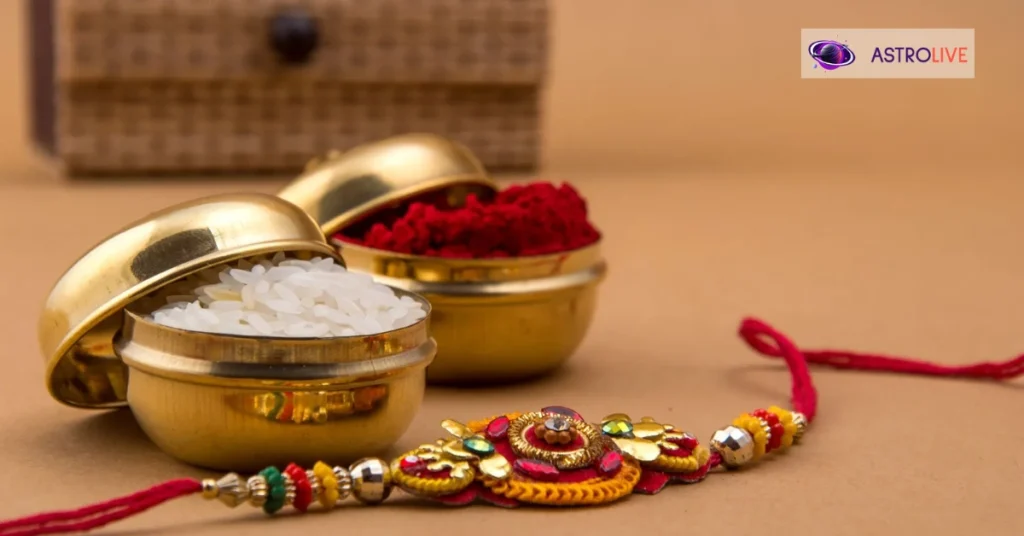Raksha Bandhan is more than just a festival; it’s a cherished tradition that symbolizes the enduring bond of love and protection between siblings. Celebrated with deep emotional and spiritual significance, it continues to unite families, create memories, and reaffirm bonds year after year.
As we look ahead to Rakhi, it’s important to know the exact timings, traditions, and rituals that make this festival so meaningful. In this blog, we’ll cover everything from the muhurat and date to rituals and gift ideas, your complete guide to making Rakhi 2025 special.
Why Raksha Bandhan Is Celebrated?
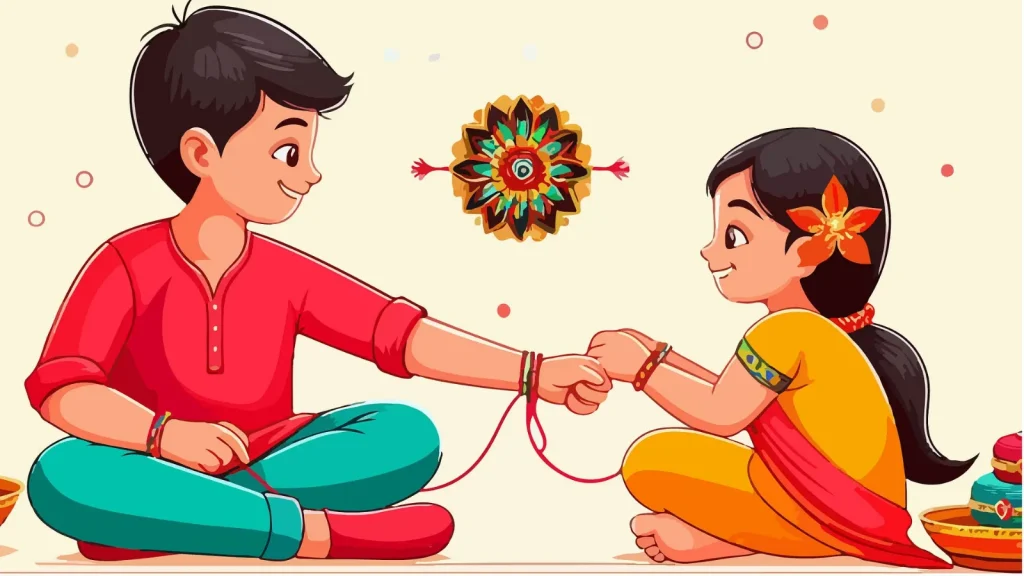
Raksha Bandhan, rooted in the Sanskrit terms Raksha (protection) and Bandhan (bond), is a beloved Indian festival that honors the sacred bond between siblings. On this special day, sisters tie a Rakhi a beautifully adorned sacred thread, around their brothers’ wrists as a gesture of love, heartfelt prayers, and wishes for their happiness and well-being. In return, brothers offer gifts and take a lifelong vow to protect their sisters against all odds.
More than just a ritual, This Festival signifies deep emotional values, love, loyalty, and mutual respect. While traditionally observed between biological siblings, the festival has evolved to celebrate any meaningful bond, including cousins, close friends, and even those who share a sibling-like connection.
It reinforces the cultural importance of family unity, moral responsibility, and unconditional support in Indian society.
When Is Raksha Bandhan 2025?
Raksha Bandhan 2025 falls on Saturday, August 9. While the festival is always celebrated on the Purnima (Full Moon Day) of the Hindu month of Shravana, the specific muhrat (auspicious time) changes every year.
For 2025, here’s a detailed breakdown of the raki tide muhrat, including the most auspicious time to perform the Rakhi ceremony:
Timings And Muhurat For Rakhi Festival 2025
Purnima Tithi (Full Moon Period):
- Begins: 2:12 PM on August 8, 2025
- Ends: 1:24 PM on August 9, 2025
This full moon day of the Shravana month marks the celebration of Raksha Bandhan. The presence of Purnima Tithi is essential, as Rakhi is traditionally tied during this lunar phase, which also aligns with the spiritual energy of the Sawan Somvar observances.
Bhadra Kaal (Inauspicious Period):
- Ends: Before sunrise on August 9, 2025
According to Hindu astrology, Bhadra Kaal is considered inauspicious for performing sacred rituals like Rakhi tying. Thankfully, in 2025, Bhadra concludes before sunrise, making it possible to begin the celebrations early in the day.
Check Panchang For Shubh Muhurat
Auspicious Time for Rakhi Tying Ceremony (Shubh Muhurat): Rakhi Bandhne Ka Sahi Time
- Thread Ceremony Time: 6:01 AM to 1:24 PM on August 9, 2025
- Duration: 7 hours and 23 minutes
Since Bhadra Kaal ends before sunrise, the entire window from 6:01 AM to 1:24 PM is considered auspicious for performing the Rakhi tying ceremony.
Key Ritual Considerations
Avoid Inauspicious Timings – Be Mindful of Bhadra Kaal:
In Hindu traditions, Bhadra Kaal is regarded as an unfavorable time for conducting auspicious ceremonies, including Rakhi tying. Performing rituals during Bhadra is believed to bring obstacles or negative outcomes.
Thankfully, in 2025, Bhadra ends before sunrise on August 9, ensuring that the Rakhi Muhurat begins only after Bhadra is over. This means the entire morning period is free of inauspicious influences, making it a safe and spiritually clean window for the celebrations.
Follow Aparahna Timing – The Most Auspicious Window:
The ideal time to tie Rakhi is during the Aparahna period, between late morning and early afternoon. In 2025, the Rakhi Muhurat from 6:01 AM to 1:24 PM on August 9 aligns perfectly with this window, making it the most auspicious time to strengthen sibling bonds and receive blessings.
Also Read: What Makes Savan Somvar Vrat So Powerful In 2025?
What Are The Traditional Rituals Of Raksha Bandhan?
While timing is crucial, so is following the right rituals. Here’s how it is traditionally celebrated in Indian households:
Pooja Thali Preparation:
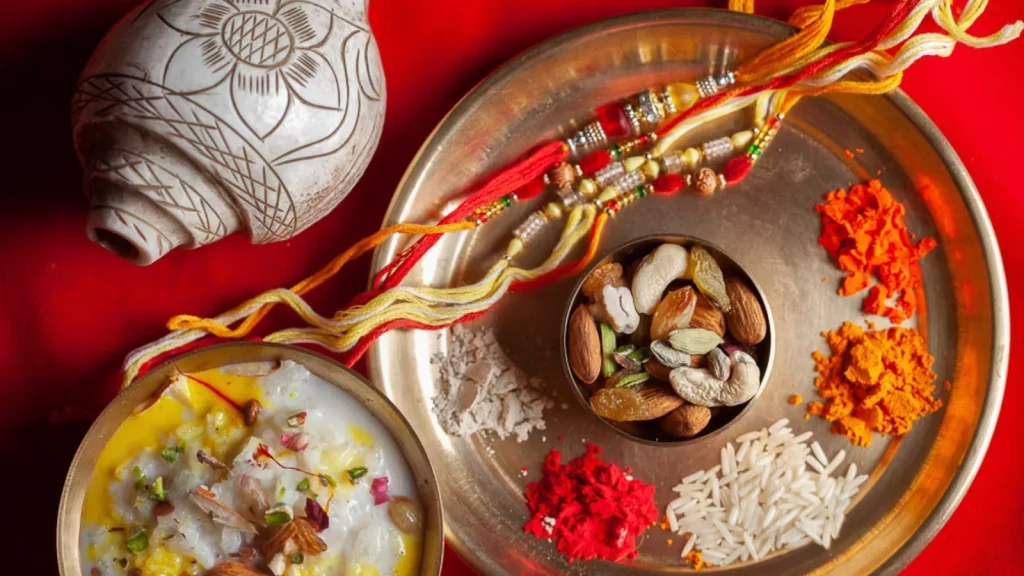
The sister begins the ritual by preparing a Pooja thali, a beautifully arranged plate containing a lit diya (lamp), Rakhi thread, grains of rice, roli (kumkum), sweets, and sometimes a coconut. Each item carries spiritual symbolism, representing purity, light, protection, and auspiciousness.
Tilak and Aarti:
The ceremony commences with the sister applying a sacred tilak (vermilion mark) on her brother’s forehead to bless him with good fortune. She then performs an aarti, gently circling the diya around him, invoking divine protection and prosperity.
Tying of Rakhi:
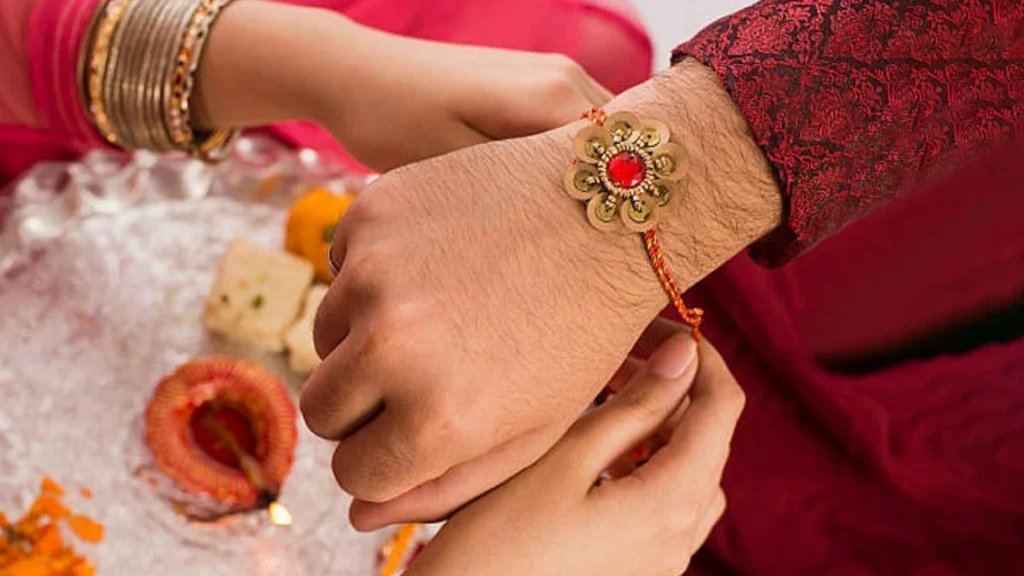
The sister ties the Rakhi around her brother’s wrist, offering prayers for his health, happiness, and long life. The thread acts as a symbol of her unconditional love and trust, while the brother promises to protect her always.
Sharing Sweets:
After the Rakhi is tied, both siblings exchange sweets, signifying the sweetness of their bond and the joyous nature of the occasion. This gesture adds a festive touch and marks the completion of the ritual with warmth and affection.
Exchange of Gifts:
The brother then offers a thoughtful gift to his sister, ranging from traditional presents to personalized surprises, as a token of gratitude and love. This exchange strengthens the emotional connection and reflects the mutual respect in their relationship.
Rakhi is more than just a tradition; it is a celebration of timeless sibling love, emotional strength, and heartfelt promises that last a lifetime.
What Is The Symbolic Meaning Behind The Rakhi Thread?
The Rakhi is far more than just a colorful, decorative thread; it is a sacred emblem of protection, love, and lifelong commitment between siblings. In Indian tradition, it carries powerful emotional and spiritual meaning.
A Sacred Bond Beyond Blood
Tying a Rakhi symbolizes a sister’s heartfelt prayers for her brother’s well-being and the brother’s solemn vow to protect her in all circumstances. Today, the ritual has evolved to honor bonds beyond biological siblings, including cousins, friends, and even spiritual or emotional siblings.
Famous Legends Behind Raksha Bandhan:
Draupadi & Lord Krishna:
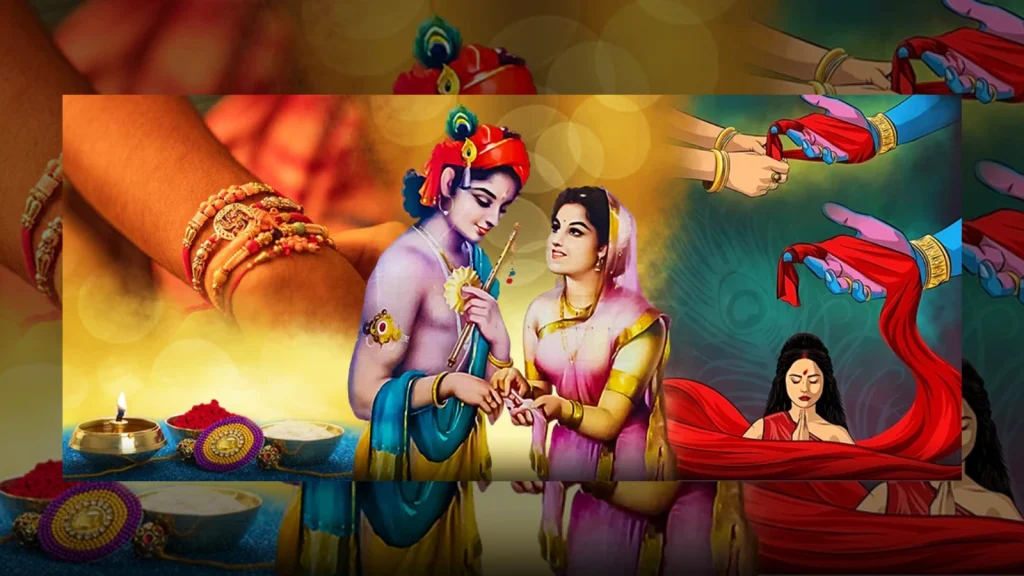
When Draupadi tore a piece of her saree to wrap around Krishna’s bleeding finger, he was deeply touched and promised to protect her forever. This heartfelt gesture is considered one of the earliest symbolic origins of Raksha Bandhan.
Rani Karnavati & Emperor Humayun:
During a time of impending invasion, Rani Karnavati of Mewar sent a Rakhi to Mughal Emperor Humayun, requesting his protection. Honoring the gesture, he rushed to defend her kingdom, showing that the Rakhi holds power even across political and religious lines.
These legends reflect the emotional and cultural depth of the festival, proving that this festival is not just a tradition but a timeless pledge of honor and care.
How Is Rakhi Celebrated In Modern Times?
With changing times and evolving lifestyles, many families are adding a modern touch to their celebrations.
Eco-Friendly Rakhis:
As environmental awareness grows, many people are turning to eco-friendly Rakhis made from natural materials like jute, cotton, seed paper, or recycled paper. These biodegradable options help reduce waste and align celebrations with sustainable values.
Some seed Rakhis can even be planted afterward, growing into plants that symbolize the love between siblings.
Virtual Celebrations:
For siblings living in different cities or countries, celebrations have adapted to the digital age. Video calls and virtual Rakhi rituals allow families to celebrate together despite the distance.
Online Rakhi and gift delivery services make it easy to maintain tradition while staying connected across borders.
Personalized Gifts:
Personalized gifts have become a popular trend, adding emotional value to Raksha Bandhan gifting. Items like customized mugs, photo frames, name-engraved jewelry, or digital gift cards offer a unique and meaningful touch.
These thoughtful choices reflect effort and deepen the personal bond between siblings.
You Might Also Like: Nag Panchami 2025: Date, Tithi, Puja Vidhi, & Significance
What Are The Best Gift Ideas For Raksha Bandhan?
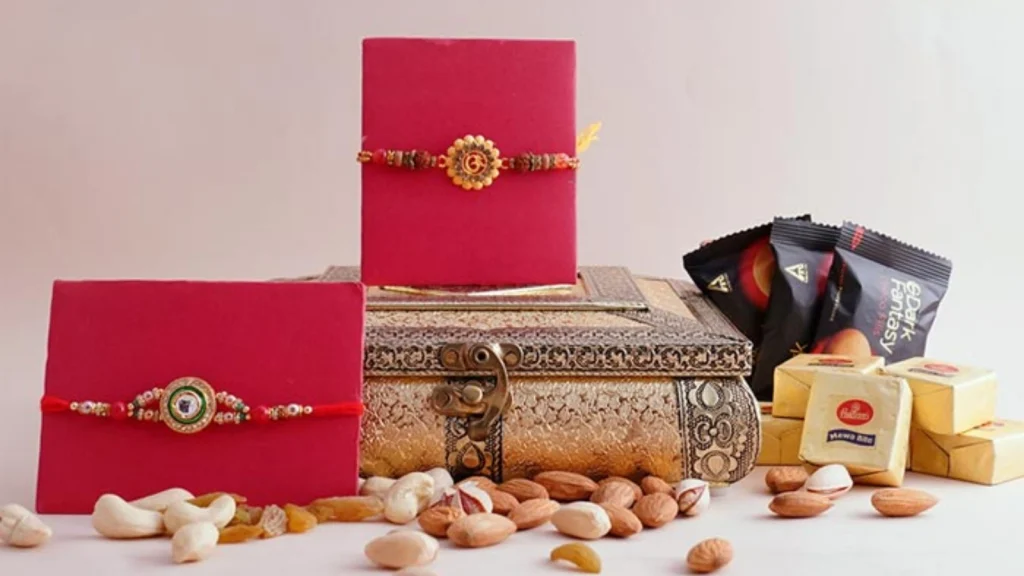
Let’s face it, gifting is one of the most exciting parts of the celebration! Here are some great ideas:
Gift Ideas For Brothers:
- Stylish wallets, watches, or sunglasses
- Books, grooming kits, or tech gadgets
- Fitness trackers or smart speakers
Gift Ideas For Sisters:
- Jewelry, cosmetics, or perfume sets
- Handbags or ethnic wear
- Spa vouchers or subscription boxes
Whatever you choose, a thoughtful gift paired with love and heartfelt wishes is sure to make this Raksha Bandhan unforgettable.

Why Raksha Bandhan Still Matters In 2025?
Despite changing times, the festival retains its emotional core. In 2025, when life moves at lightning speed, it serves as a gentle reminder of our roots, relationships, and responsibilities toward our loved ones.
It’s not just about traditions, it’s about creating memories, sharing laughter, and expressing gratitude. Whether you’re together or apart, Rakhi provides the perfect occasion to strengthen your sibling bond.
Conclusion: Make Raksha Bandhan Special
As you get ready for Raksha Bandhan 2025, keep in mind that the most auspicious time to perform the Rakhi ceremony is between 6:01 AM and 1:24 PM on Saturday, August 9, once Bhadra Kaal has ended. Following this auspicious window ensures your celebration aligns with traditional Hindu practices and invites positivity and blessings into your home.
With meaningful rituals, thoughtful gifts, and heartfelt emotions, this timeless celebration strengthens bonds and honors the love between siblings, whether you’re near or far.
So mark your calendar, avoid the Bhadra time, plan your surprises, and celebrate the sacred sibling bond with a full heart and joy.
And for accurate Muhurat timings or personalized astrological guidance, connect with expert astrologers on AstroLive —because every ritual shines brighter when it’s aligned with the stars.


